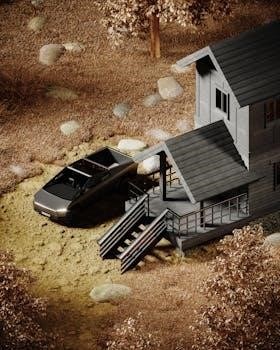Edgar Allan Poe’s “The Fall of the House of Usher,” published in 1839, masterfully blends supernatural horror and Gothic themes. The narrative introduces isolation, madness, and family decline. Its eerie atmosphere and psychological depth make it a timeless exploration of human frailty and decay.
Edgar Allan Poe’s “The Fall of the House of Usher,” initially published in 1839, stands as a quintessential work of Gothic horror. The tale delves into the depths of human psychology, exploring themes of isolation, madness, and the decay of both the mind and the physical world. Poe masterfully crafts an atmosphere of dread and suspense, drawing readers into the unsettling world of the Usher siblings and their ancestral home.
The story’s enduring appeal lies in its ability to tap into primal fears and anxieties. The decaying mansion serves as a physical manifestation of the Usher family’s decline, reflecting their mental and physical deterioration. Poe’s use of symbolism and imagery enhances the story’s emotional impact, leaving a lasting impression on the reader.
Through vivid descriptions and psychological insight, Poe invites us to contemplate the fragility of human existence and the destructive power of unchecked despair; “The Fall of the House of Usher” remains a chilling reminder of the darkness that can consume individuals and families, ultimately leading to their demise.
The narrative’s exploration of metaphysical identities further complicates its themes, prompting readers to question the nature of reality and the boundaries between the physical and spiritual realms. Poe’s genius lies in his ability to weave together these intricate elements into a cohesive and unforgettable tale of horror and psychological torment.
Plot Summary⁚ The Narrator’s Arrival and Roderick’s Condition

The narrative commences with the unnamed narrator’s arrival at the Usher mansion, a place he approaches with a palpable sense of dread. Summoned by Roderick Usher, his childhood friend, the narrator is immediately struck by the house’s oppressive atmosphere and decaying facade. This sets the stage for the unfolding drama, foreshadowing the doom that awaits within.
Roderick’s condition is revealed as one of profound mental and physical decline. He suffers from a mysterious illness, marked by heightened senses, acute anxiety, and a pervasive sense of despair. Roderick’s letter, filled with desperation, hints at the depths of his suffering and his hope that the narrator’s presence will alleviate his torment.
The narrator’s observations of Roderick paint a portrait of a man consumed by his own internal demons. Roderick’s artistic pursuits and intellectual interests seem only to exacerbate his condition, driving him further into isolation and madness. His connection to his twin sister, Madeline, is also highlighted, hinting at a deeper, perhaps supernatural, bond between them.
As the narrator settles into the Usher mansion, he becomes increasingly aware of the oppressive atmosphere and the pervasive sense of unease. The house itself seems to mirror Roderick’s deteriorating state, blurring the lines between the physical and psychological realms; The stage is thus set for a descent into darkness and the unraveling of the Usher family’s tragic fate.
The Significance of the House Itself
The House of Usher is far more than a mere setting; it is a central character in Poe’s tale, embodying the physical and psychological decay that plagues the Usher family. Its very structure reflects the family’s decline, with crumbling walls, a barely perceptible fissure running from roof to foundation, and an overall sense of oppressive gloom.
The house’s atmosphere is described as having absorbed an evil and diseased influence from the surrounding landscape. This suggests that the house is not merely a passive recipient of the Usher family’s troubles but an active participant in their downfall, amplifying their fears and contributing to their madness.

The tarn, a dark and stagnant pool surrounding the house, further reinforces its symbolic significance. The inverted image of the house reflected in the water creates a sense of unease and distortion, suggesting that reality itself is warped within the Usher estate.
The house also represents the Usher family’s isolation from the outside world. Its remote location and imposing presence serve to cut them off from society, exacerbating their sense of alienation and contributing to their descent into madness. In essence, the House of Usher is a physical manifestation of the family’s decaying lineage and their impending doom, blurring the line between the psychological and the tangible.
Madeline Usher’s Illness and Apparent Death
Madeline Usher’s illness is shrouded in mystery, adding to the story’s atmosphere of dread and uncertainty. She suffers from a debilitating ailment that resists diagnosis, characterized by a gradual wasting away and cataleptic trances. Her condition mirrors the decay of the Usher family and the house itself, suggesting a deep connection between her physical state and the family’s decline;
As Madeline’s health deteriorates, she becomes increasingly withdrawn and isolated, further emphasizing the theme of confinement within the Usher estate. Her eventual apparent death plunges Roderick into even deeper despair and madness, highlighting the profound bond between the siblings. Roderick’s decision to entomb Madeline in the family vault, rather than burying her, is driven by a fear that her body might be exhumed for scientific examination.
This decision proves fateful, as it sets the stage for Madeline’s eventual return and the story’s climactic events. The entombment scene underscores the themes of premature burial and the blurring of the line between life and death, common motifs in Poe’s work. Madeline’s illness and apparent death serve as a catalyst for the unraveling of the Usher family and the ultimate collapse of their ancestral home.
Roderick’s Mental State and Artistic Pursuits
Roderick Usher’s mental state is central to the story’s exploration of madness and psychological decay. He suffers from a heightened sensitivity to sensory stimuli, experiencing acute anxiety and hypochondria. Roderick’s artistic pursuits, including painting, music, and poetry, serve as outlets for his tormented mind, reflecting his inner turmoil and distorted perceptions of reality.
His artistic endeavors are often characterized by a morbid and unsettling aesthetic, mirroring the gloomy atmosphere of the Usher mansion. Roderick’s paintings depict abstract and disturbing scenes, while his music is filled with melancholy and dissonance. These artistic expressions provide insight into his deteriorating mental condition and his obsession with death and decay.
As Roderick’s mental state worsens, he becomes increasingly reclusive and isolated, further fueling his descent into madness. His artistic pursuits become a desperate attempt to cope with his inner demons and to find meaning in a world that seems increasingly hostile and oppressive. Ultimately, Roderick’s artistic endeavors fail to provide solace, and he succumbs to the overwhelming forces of his own mind and the decaying influence of the Usher lineage.
The Poem “The Haunted Palace” and its Connection to the Story
Poe’s inclusion of the poem “The Haunted Palace” within “The Fall of the House of Usher” serves as a crucial symbolic element, mirroring the Usher family’s decline. The poem narrates the transformation of a once-majestic and vibrant palace into a desolate and haunted ruin, reflecting the deterioration of both Roderick Usher’s mental state and the Usher family’s legacy.
Initially, the palace represents a harmonious and flourishing state, with “thought and reason” adorning its halls. However, as the poem progresses, it depicts the palace’s descent into madness and decay, symbolized by the invasion of “evil things” and the transformation of its windows into “red-litten” eyes.
The parallels between the poem and the story are striking, with the palace serving as an allegory for the Usher family and its ancestral home. Just as the palace succumbs to darkness and ruin, the Usher family faces its own demise, plagued by madness, isolation, and the weight of its decaying lineage. The poem’s haunting imagery and melancholic tone amplify the story’s themes of decay, madness, and the inevitable fall of once-great entities.
The Burial of Madeline and the Increasing Tension
The premature burial of Madeline Usher in the family vault marks a pivotal point in Poe’s “The Fall of the House of Usher,” dramatically escalating the story’s atmosphere of dread and suspense. Following Madeline’s apparent death from a mysterious illness, Roderick Usher, along with the narrator, inters her within the catacombs beneath the mansion.
This act, driven by Roderick’s increasingly erratic mental state and a fear of external scrutiny, further isolates the Usher siblings and intensifies the oppressive atmosphere within the house. As the narrator assists in carrying Madeline’s coffin, he notes the striking resemblance between the siblings, hinting at a deeper, more unsettling connection.
Following the entombment, the narrator observes a marked deterioration in Roderick’s mental and physical condition. Roderick becomes increasingly agitated, haunted by inexplicable sounds that seem to emanate from within the house. These sounds, vaguely resembling Madeline’s struggles within the vault, contribute to the mounting tension and foreshadow the impending climax of the story. The burial serves as a catalyst, accelerating the Ushers’ descent into madness and sealing their tragic fate.
The Climax⁚ Madeline’s Return and the Ushers’ Demise

The climax of “The Fall of the House of Usher” erupts with Madeline’s horrifying return from her premature entombment, culminating in the tragic demise of both Usher siblings and the symbolic collapse of the ancestral house. As Roderick and the narrator attempt to distract themselves with a story, the sounds described in the tale eerily mirror noises emanating from within the mansion.
Roderick, driven to the brink of madness, confesses that he has been hearing these sounds for days, realizing that they are Madeline’s desperate attempts to escape her tomb. Suddenly, the doors of the chamber burst open, revealing Madeline, gaunt and bloodied, standing before them.
In her weakened state, she falls upon Roderick, and both siblings perish in a final, fatal embrace. The narrator, witnessing this horrific scene, flees in terror as the House of Usher, representing the physical and psychological decay of the Usher lineage, crumbles and sinks into the tarn, signifying the complete and utter annihilation of the Usher family.
Themes of Isolation, Madness, and Family
“The Fall of the House of Usher” explores the interconnected themes of isolation, madness, and the destructive power of family legacy. Roderick Usher’s profound isolation, both physical and mental, is a driving force behind his descent into madness. Confined within the decaying Usher mansion, he is cut off from the outside world, exacerbating his mental and emotional instability.
Madeline’s illness and Roderick’s deteriorating mental state further contribute to the atmosphere of decay and despair. The story suggests that the Usher family’s history of incestuous relationships and genetic abnormalities has led to a weakening of their bloodline, predisposing them to mental and physical ailments.
The house itself becomes a symbol of the Usher family’s isolation and decay, reflecting their psychological state and foreshadowing their ultimate demise. The crumbling structure and oppressive atmosphere mirror the Ushers’ internal turmoil, highlighting the destructive consequences of isolation, madness, and a tainted family history.

The Fall of the House of Usher⁚ Summary and Analysis
The Symbolic Fall of the House
The literal collapse of the House of Usher at the story’s climax serves as a potent symbol of the Usher family’s downfall and the culmination of their tragic fate. The house, described as ancient and decaying, represents the Usher lineage itself, burdened by a history of isolation, madness, and incest.
As Roderick and Madeline Usher succumb to their respective fates, the physical structure of the house mirrors their internal collapse. The cracks and fissures that have long plagued the mansion finally give way, leading to its complete disintegration. This symbolizes the irreversible damage inflicted by their family’s dark secrets and psychological struggles.
The fall of the house also signifies the end of the Usher bloodline, with Roderick and Madeline being the last of their kind. Their demise marks the extinction of a family that has become consumed by its own internal demons. The symbolic collapse underscores the destructive consequences of unchecked isolation, inherited madness, and the weight of a decaying legacy.
